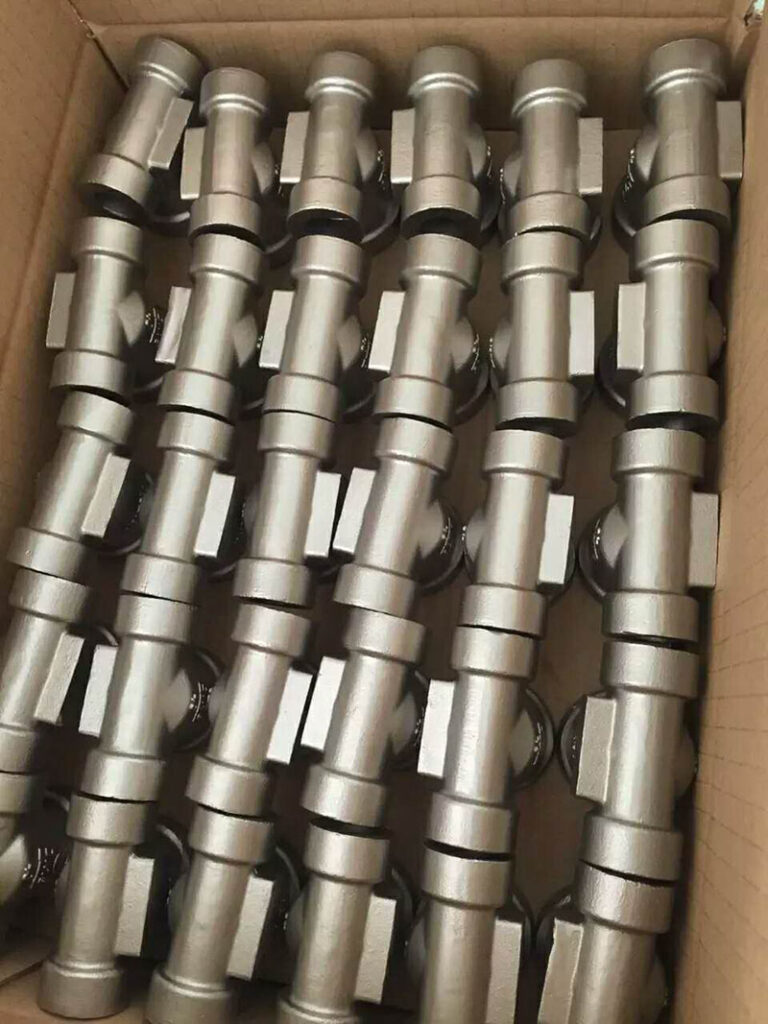Introduction
In semiconductor manufacturing, where a single microscopic contaminant can destroy millions of dollars worth of silicon wafers, the cleanliness of equipment components becomes paramount. Copper-free stainless steel castings must achieve Class 10 cleanliness (fewer than 10 particles ≥0.5μm per cubic foot) to prevent wafer contamination. Through specialized manufacturing protocols and rigorous contamination control, we’ve supplied 5,000+ critical components to leading semiconductor equipment manufacturers while maintaining 99.995% on-time delivery with zero contamination-related rejections.
1. The Critical Importance of Copper Elimination
1.1 Copper Contamination Risks in Semiconductor Processes
Device-Killing Effects:
- Transistor Poisoning: Cu atoms migrate into silicon, altering electrical properties
- Interface States: Increased leakage current and reduced gate oxide integrity
- Yield Impact: 0.1ppb Cu can cause >50% yield loss in sub-10nm nodes
Industry Standards for Copper Content:
| Standard | Maximum Copper Content | Application Scope |
|---|---|---|
| SEMI F72 | ≤0.10% | General components |
| Our Internal Standard | ≤0.01% | Critical components |
| Extreme Cases | ≤0.005% | EUV lithography systems |
1.2 Material Selection Strategy
Copper-Free Stainless Steel Options:
- 316L Variants: Custom melts with Cu <0.01%
- 304L: Naturally lower copper content
- High-Purity Alloys: Specialty grades for extreme applications
Certified Material Sources:
- Melt Practice: VIM-VAR (Vacuum Induction Melting + Vacuum Arc Remelting)
- Traceability: Heat-specific certification with full chemistry disclosure
- Verification: Glow Discharge Mass Spectrometry (GDMS) analysis
2. Clean Manufacturing Facility Requirements
2.1 Controlled Environment Specifications
Cleanroom Classifications:
| Area | ISO Class | Particle Count (≥0.5μm) | Temperature Control |
|---|---|---|---|
| Pattern Making | ISO 7 | ≤352,000/m³ | ±1℃ |
| Shell Building | ISO 6 | ≤35,200/m³ | ±0.5℃ |
| Final Cleaning | ISO 4 | ≤3,520/m³ | ±0.2℃ |
| Packaging | ISO 3 | ≤352/m³ | ±0.1℃ |
Environmental Monitoring:
- Real-time Particle Counting: 25 locations throughout facility
- Air Changes: 60-100 changes per hour in critical areas
- Pressure Cascades: +15 Pa between cleanliness zones
2.2 Personnel and Material Flow Control
Staff Protocols:
- Gowning Requirements: Full cleanroom suits with face masks
- Training: 40-hour contamination control certification
- Health Screening: Regular particle shedding assessments
Material Handling:
- Double Bagging: Transition between cleanliness zones
- Surface Passivation: All tools and fixtures electropolished
- Non-shedding Materials: PFA, PTFE, or 316L surfaces only
3. Specialized Casting Process for High Purity
3.1 Raw Material Preparation
Charge Material Selection:
- 316L Composition Control:textCr: 16.5-18.5% Ni: 10.0-14.0% Mo: 2.0-3.0% Cu: ≤0.01% (target ≤0.005%) C: ≤0.025%
- Recycled Material: Zero internal scrap reuse for semiconductor parts
- Additive Purity: 99.99% pure alloying elements only
3.2 Melting and Pouring Controls
Crucible Selection:
- Zirconia-Based: Zero copper contamination risk
- Single Use: Discard after each heat despite cost
- Pre-firing: 1200℃ for 4 hours to remove volatiles
Atmosphere Control:
- Vacuum Melting: <0.1 Pa ultimate pressure
- Argon Cover: 99.9999% purity during pouring
- Temperature Control: ±3℃ for optimal fluidity
3.3 Shell System Purity
Ceramic Material Specifications:
- Zircon Sand: 99.8% purity, acid washed
- Binder System: Colloidal silica, low sodium variant
- Firing Protocol: 1000℃ for 2 hours to remove organics
Contamination Prevention:
- Dedicated Tools: Separate from commercial production
- Water Treatment: 18 MΩ-cm deionized water only
- Regular Audits: Weekly swab testing for ionic contamination
4. Cleaning and Surface Treatment Protocol
4.1 Multi-Stage Cleaning Process
Stage 1: Gross Contaminant Removal
- Alkaline Cleaning: pH 10.5, 60℃, 30 minutes
- Ultrasonic Assistance: 40 kHz for particle dislodgement
- Rinse: Overflow DI water rinse
Stage 2: Ionic Contamination Removal
- Acid Passivation: 20% HNO₃, 50℃, 2 hours
- Multiple Rinses: 3-stage countercurrent DI rinse
- Final Rinse: 18 MΩ-cm DI water
Stage 3: Particle Removal
- Megasonic Cleaning: 800 kHz for sub-micron particles
- High-Purity Water: Filtered to 0.1μm absolute
- Spin Rinse Dryer: Centrifugal force drying
4.2 Surface Passivation
Electropolishing Parameters:
- Solution: Phosphoric-sulfuric acid mixture
- Temperature: 65±2℃
- Current Density: 25-35 A/dm²
- Resulting Surface: Ra <0.2μm, Cr/Fe ratio >1.5
Quality Verification:
- XPS Analysis: Surface chemistry confirmation
- Auger Electron Spectroscopy: Elemental depth profile
- SEM Inspection: Surface topography examination
5. Packaging and Shipping Controls
5.1 Clean Packaging Materials
Material Specifications:
- Bags: Double-layer static-dissipative polyethylene
- Labels: Low-outgassing adhesive, copper-free
- Cushioning: Cleanroom-certified foam only
Packaging Environment:
- ISO Class 3: Final packaging area
- Laminar Flow: HEPA-filtered workstations
- Sealing: Heat sealing to prevent particle ingress
5.2 Documentation and Traceability
Certificate of Conformance Includes:
- Material chemistry with GDMS verification
- Cleanliness test results per IEST-STD-CC1246
- Packaging integrity certification
- Full traceability to melt heat number
6. Quality Assurance and Testing
6.1 Cleanliness Verification
Particle Counting:
- Liquid Particle Counting: Filter extraction method
- Airborne Particle Monitoring: Real-time in cleanrooms
- Acceptance Criteria: <5 particles ≥0.5μm per component
Ionic Contamination Testing:
- Ion Chromatography: Extract solution analysis
- Acceptance Limits: <0.1 μg/cm² for each ion species
- Regular Monitoring: Weekly correlation testing
6.2 Functional Testing
Helium Leak Testing:
- Sensitivity: <1 × 10⁻⁹ atm·cc/sec
- Method: Mass spectrometer leak detection
- Application: Hermetically sealed components
Surface Analysis:
- SEM/EDS: Elemental mapping for contaminants
- White Light Interferometry: Surface topography
- Contact Angle: Surface energy measurement
7. Case Study: EUV Lithography Chamber Component
Challenge:
- Application: Extreme Ultraviolet Lithography source chamber
- Requirements: Class 1 cleanliness, Cu <0.005%
- Component Size: 450mm diameter, complex internal channels
Solution Implementation:
- Material: Custom VIM-VAR 316L with Cu 0.003%
- Manufacturing: Isolated cleanroom facility
- Cleaning: 7-stage cleaning with final megasonic
- Packaging: Class 1 cleanroom, double bagging
Results:
- Cleanliness: Class 1 verified (0 particles ≥0.5μm)
- Copper Content: 0.0028% by GDMS
- Customer Acceptance: First article approval
- Performance: 18 months operation with zero contamination issues



One Response
Achieving Class 10 cleanliness in copper-free stainless steel castings requires an integrated approach spanning material selection, manufacturing environment control, specialized processes, and rigorous verification. As semiconductor feature sizes continue to shrink, the demands on equipment component cleanliness will only increase. Manufacturers who invest in the necessary infrastructure and expertise today will be positioned to support the next generation of semiconductor technology advancement.